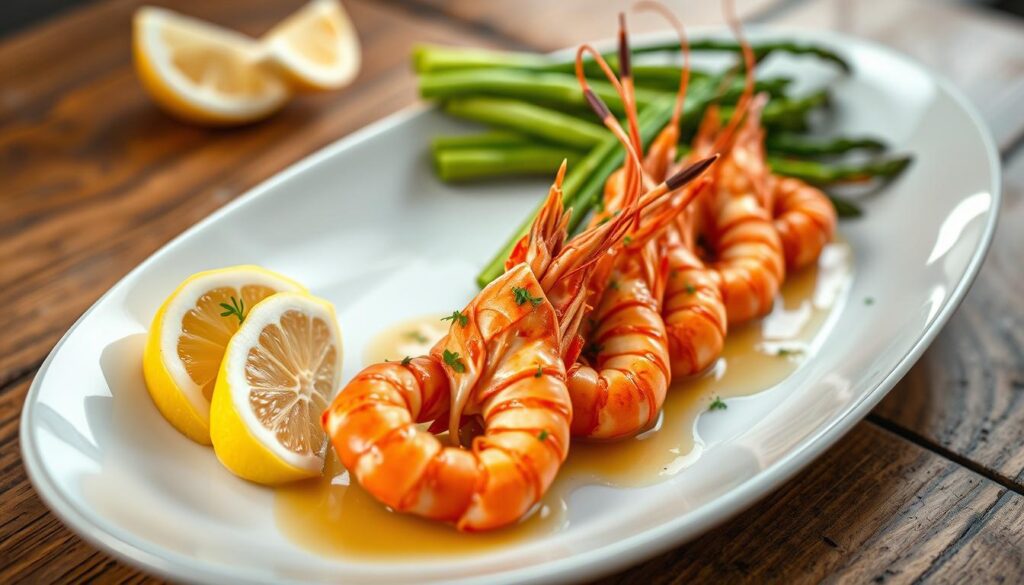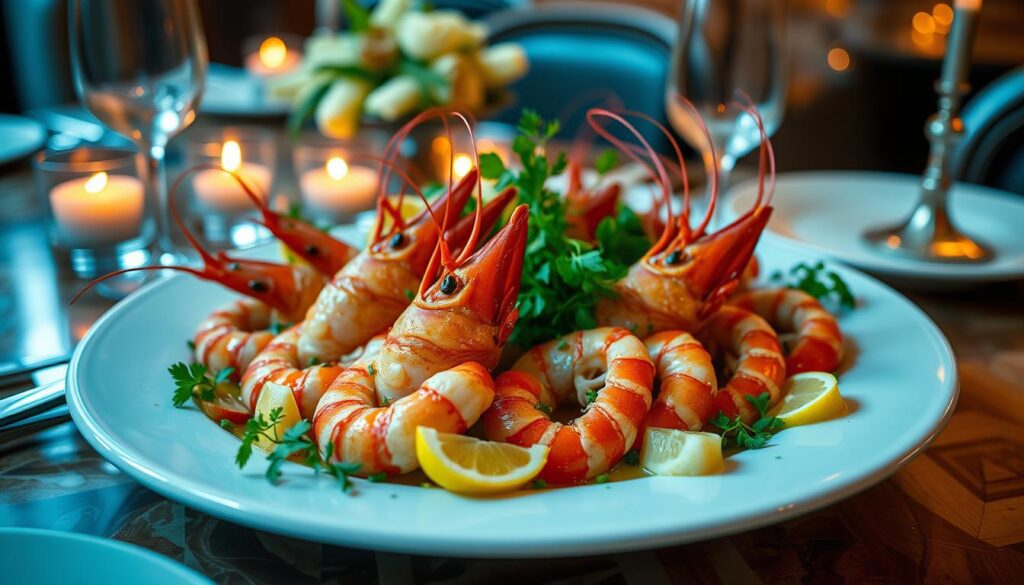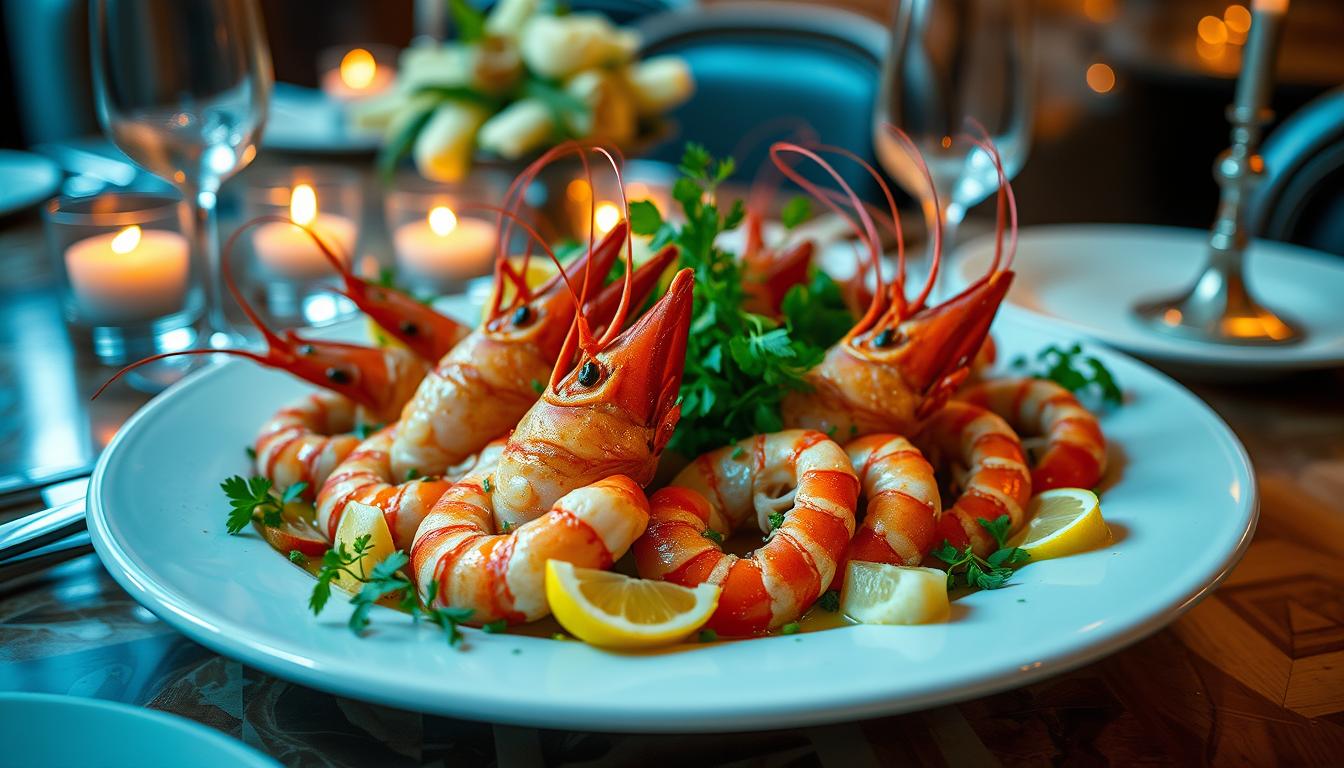Discover my favorite easy langoustine recipes for mouthwatering seafood dinners. Learn how to cook these delicate crustaceans like a pro and impress your guests.
Table of Contents
Ah fresh langoustines !. These crustaceans, also called Norway lobsters or scampi, calling me to start a cooking journey. Their sweet, tender meat and luxurious feel make them a true seafood delicacy.
Growing up by the coast, I remember my grandmother’s amazing langoustine dishes. Each dish showed the magic of simple, yet perfect recipes. I picked the best ones, excited to make those flavors in my kitchen. I wanted to share the joy of langoustine cooking with my loved ones.
Key Takeaways
- Discover the versatility of langoustines in a variety of easy and delicious seafood recipes
- Learn about the distinct flavor and texture of these crustacean delicacies
- Explore classic langoustine dishes as well as innovative rice-based recipes
- Gain practical tips for selecting, cleaning, and preparing langoustines to elevate your culinary skills
- Understand the importance of utilizing the langoustine stock to maximize flavor in your dishes
Introduction to Langoustine Delicacies
Langoustines are a fascinating crustacean loved by many. They live in the cold, deep waters of the North Atlantic and Mediterranean. Their delicate taste and soft texture make them a favorite among chefs and home cooks.
What are Langoustines?
Langoustines are a type of crustacean related to lobsters and shrimp. They are also known as scampi in Italy and cigalas in Spain. These small creatures have long claws and a soft, clear shell.
Why are Langoustines Considered a Luxury?
Langoustines are seen as a luxury for several reasons. They are rare and hard to find, unlike shrimp or prawns. Their delicate flavor and soft texture are highly valued. They are also hand-harvested, adding to their luxury status.
| Langoustine Fun Facts | Data |
|---|---|
| Spanish Langoustine Consumption | The Spanish buy up to half of England’s Langoustine catch, referring to them as cigalas. |
| Italian Langoustine Terminology | In Italy, Langoustines are called gli scampi (lo scampo, in the singular). |
| Langoustine Dish Preference in Italy | The author’s favorite dish was grilled Langoustines during the trip down the Adriatic coast. |
| Langoustine Preparation in Southern Italy | In the South of Italy, Langoustines are served with peperoncino e la menta, a combination of red chili peppers and mint. |
In this section, we’ll explore the fascinating world of langoustines. We’ll learn about their unique traits and why they’re a delicacy in cooking.
Classic Langoustine Dishes
Langoustines are delicate and flavorful. They’re great in many seafood dishes. I’ll share two tasty recipes: Langoustine Spaghetti with Garlic Butter and Langoustine Soup.
Langoustine Spaghetti with Garlic Butter
Imagine spaghetti tossed with langoustine meat in a garlicky butter sauce. It’s a treat for your taste buds. The langoustines add a sweet flavor, while garlic and butter make it silky.
You’ll need 10 fresh langoustines (about 500g), 250g spaghetti, and a dressing of 100ml olive oil and one lemon’s juice.
Grill the langoustines for 4-5 minutes on the shell side. Then, flip them and grill for 1-2 minutes on the meat side. This makes them tender.
After grilling, take out the meat and set it aside. Cook the spaghetti and drain it. Then, add the langoustine meat, garlic butter, and some cooking liquid. Toss it all together and serve, garnished with langoustine halves.
Langoustine Soup: A Coastal Delight
Langoustine Soup is a comforting dish. It’s sweet and flavorful. You’ll need 6 langoustines, 100g cherry tomatoes, 3 tablespoons vegetable broth (or unsweetened white grape juice), and 150ml cream.
Sauté the langoustines until they’re lightly browned. Remove the meat and save the shells for stock. Sauté cherry tomatoes and a splash of vegetable broth (or unsweetened white grape juice) in the same pan.
Make a stock with the langoustine shells and water. Boil, then simmer for 30 minutes. Strain and add the stock to the pan. Stir in the langoustine meat, cherry tomatoes, and cream. Serve hot, garnished with langoustine claws.

Langoustine Rice Recipes
Langoustines add a special touch to rice dishes, bringing a coastal flavor. We’ll look at two tasty langoustine rice recipes. They will make your seafood meals even better.
Creamy Rice with Langoustines
This creamy dish highlights the langoustines’ sweet taste. You’ll need 8 frozen langoustines, peeled, 60ml vegetable broth (or unsweetened white grape juice), and 1.5 liters fish stock. The langoustines simmer in the stock, making a creamy base for the rice.
This creates a rich seafood risotto. It’s perfect for impressing your guests.
Paella with Langoustines
Langoustines are great in paella, a classic Spanish dish. You’ll need 400g paella rice, 300g haddock fillet, and 8 langoustines. The langoustines add their sweet flavor to the dish.
Saffron, pimentón de la Vera, and a mix of onions, garlic, and tomatoes make it vibrant. This paella captures the authentic flavors of Spain.
| Ingredient | Quantity |
|---|---|
| Langoustines | 8 frozen raw, peeled |
| Vegetable Broth or Unsweetened White Grape Juice | 60ml |
| Fish Stock | 1.5 liters |
| Paella Rice | 400g short grain |
| Haddock Fillet | 300g |
| Saffron | 1 pinch |
| Pimentón de la Vera | 1 tsp |
| Onion | 1 large |
| Garlic | 3 cloves |
| Tomatoes | 1 lb Roma |
Both dishes will take you to Spain’s sunny coasts. Pair with lemon wedges for a refreshing touch. It highlights the seafood flavors.
Langoustines for Special Occasions
Langoustines are perfect for making any meal special. They have a sweet flavor that’s both luxurious and coastal. They’re great for holiday gatherings, romantic dinners, or fancy parties.
Langoustines are bigger than shrimp but smaller than lobster. They’re caught wild and are good for the ocean. They’re loved in Europe, especially in Spain and France.
Langoustines are a luxury because they’re hard to catch and not many are found. Over 50% of the langoustines consumed globally are sourced from Scotland. They’re caught carefully to stay fresh and tasty.

There are many ways to cook langoustines for special meals. You can roast, stir-fry, deep-fry, poach, or grill them. It’s important to cook them right to keep their flavor and texture.
Langoustines are perfect for making any dinner special. They look elegant and taste amazing. They’re a great choice for any celebratory meal.
Langoustine Preparation Tips
Getting langoustines ready is key to enjoying their sweet, tender meat. They are a delicate seafood that needs care during cleaning and deveining. Here are some tips to help you pick the freshest langoustines and prepare them for delicious dishes.
Selecting Fresh Langoustines
When you’re shopping for langoustines, look for lively ones with a bright, shiny shell. Stay away from langoustines with damaged or discolored shells. They might not be fresh anymore. Also, give them a gentle squeeze. They should feel firm and springy, not soft.
Cleaning and Deveining Langoustines
To clean and devein langoustines, start by rinsing them under cold water. With a small, sharp knife, make a shallow cut along the back. This will reveal the dark vein in the center. Gently pull out the vein and throw it away. Take care not to cut too deeply to avoid damaging the meat.
After cleaning and deveining, your langoustines are ready to cook. Whether you’re sautéing, grilling, or boiling them, these tips will make them tender and flavorful. Enjoy them as a true delight.
Cooking with Langoustine Stock
Langoustine stock can really elevate your dishes. It’s a rich seafood broth perfect for soups and sauces. It brings out the best in these delicate crustaceans.
Making Flavorful Langoustine Stock
Making your own langoustine stock is easy and worth it. Using shells and heads gives a deep flavor. Here’s how to make it:
| Prep Time | Cook Time | Serves |
|---|---|---|
| 1 hour | 30 minutes | 6 |
Ingredients:
- 2 tablespoons butter
- 1 pound of langoustine shells (or shrimp, lobster, or prawn shells)
- ¾ cup vegetable broth (or unsweetened white grape juice)
- 1 yellow onion, chopped into quarters
- 2 carrots
- 2 celery stocks
- 4 cups fish stock
- 3 cups water
- 1 teaspoon pepper
- 1 teaspoon salt
Begin by melting the butter in a large pot over medium heat. Add langoustine shells and sauté for 5-7 minutes. They should turn pink and smell good.
Next, pour in the vegetable broth (or unsweetened white grape juice) and let it simmer for a few minutes. This lets the alcohol cook off.
Next, add chopped onion, carrots, and celery. Sauté for 5 minutes. Then, pour in fish stock and water. Season with pepper and salt.
Bring to a boil, then reduce the heat. Let it simmer for 30 minutes. Skim off any foam that forms.
Once finished, strain through a fine-mesh sieve. Discard the solids. Now, you have flavorful langoustine stock for soups, sauces, and more.
Langoustine Alternatives
Langoustines are a favorite seafood treat, but they’re not always easy to find or affordable. Luckily, there are great substitutes like shrimp and prawns. These options can make dishes just as tasty and satisfying.
Substituting Shrimp or Prawns for Langoustines
Shrimp and prawns are similar to langoustines. They taste sweet and are tender. Here’s how to use them as substitutes:
- Choose medium to large shrimp or prawns to match langoustine size.
- Cook them for less time since they’re quicker to cook than langoustines.
- Think about the dish’s taste and pick shrimp or prawns that fit well with it.
- Try different cooking methods like sautéing, grilling, or roasting to get similar textures and tastes.
While langoustines are special, shrimp and prawns are great and cheaper substitutes. With some trial and error, you can make dishes that taste like langoustine treats.
| Seafood Option | Taste and Texture | Nutritional Benefits | Availability and Cost |
|---|---|---|---|
| Langoustines | Sweet, slightly briny, and delicate texture | High in protein, low in fat, and rich in vitamins and minerals like vitamin B12, phosphorus, and selenium | Primarily found in the northeastern Atlantic Ocean and parts of the Mediterranean Sea, can be more expensive due to limited availability |
| Shrimp | Mild, slightly sweet flavor and firm, succulent texture | Provides essential minerals like iodine, but has higher cholesterol levels compared to other substitutes | Widely available and generally more affordable than langoustines |
| Prawns | Slightly sweeter and more robust flavor than shrimp, with a tender, juicy texture | Comparable in nutritional value to shrimp, with high protein content and essential vitamins and minerals | Widely available and often more cost-effective than langoustines |
Conclusion
In this journey into the world of langoustines, I’ve shared many easy and tasty recipes. These recipes highlight the special flavors and uses of these luxury seafood treats. From classic dishes like spaghetti with garlic butter to creative rice dishes, I hope you’re inspired to try new things.
Langoustines, also known as Norway lobsters or Dublin Bay prawns, are loved for their tender, sweet flesh. They can make any meal special, whether it’s a big feast or a simple dinner. By following my tips on choosing, preparing, and cooking langoustines, you’ll enjoy them even more.
Keep exploring langoustine recipes and cooking methods. They can be the main attraction or a tasty addition to many dishes. By diving into langoustine cooking, you’ll add luxury and elegance to your meals. Your family and friends will love the unique tastes and textures of these seafood wonders.

